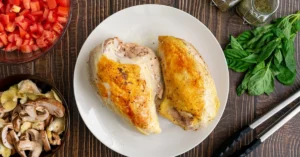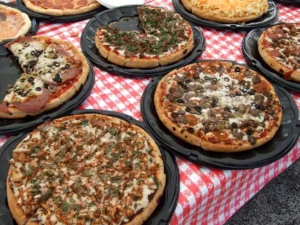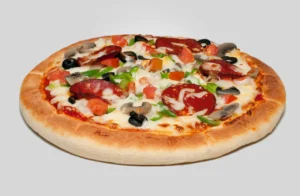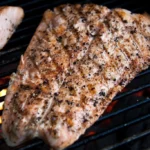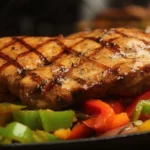Chicharrones or pork rinds are fried pig skin. It is a Spanish, Filipino, Brazilian, Cuban, and Mexican cuisine staple.
Though pork rind is the primary ingredient in chicharron, it may be made using any cut of pork. You can also make it from other types of meat like chicken, fish, and beef.
Chicharrones is the Spanish term for pork rinds, a salty, flavorful, and crispy snack popular in the United States.
This crispy snack is famous worldwide, with unique names and serving techniques that vary according to the culture.
The primary ingredient in chicharron is pig rind or pork skin. This pig rind differs from the regular salty pork skin in meat markets. It is prepared by slicing the skin from the pig’s belly with a leftover meat layer.
You can also cook Chicharron with fried chicken, mutton, or fish. Beef can also substitute for pork in this recipe. The crispy texture of the pig rinds is the dish’s feature.
These crispy rinds are seasoned with salt, pepper, and 7-spice Japanese powder. Using the pig’s skin is unnecessary, although you can combine rinds with underlying flesh.
History of Chicharron
Chicharron is a pork rind in Spanish but is attached to a pork belly with a bit of ribs meat. Though the dish’s origins are in the Spanish state of Andalusia, it has gained worldwide popularity.
Chicharones became popular in the United States in the 1990s after George H. W. Bush declared them his favorite snack.
A snack company named ‘Barcle’ even created vegetarian versions of the dish in the 1980s. Since then, many snack-food manufacturers have released their version of Chicharron.
How do They Make Chicharron?
The Chicharron recipe is quite simple. It follows the process given below.
Chicharron ingredients
To prepare a chicharron, you’ll need the following:
- One and a half to two pounds of 80/20 pork skin (with 80 percent fat and 20 percent meat)
- Two cups of canola oil
- Salt
- Salsa of choice or guacamole, optional
You can also use lemon juice, rum, minced garlic, salt, and paprika as a marinade. Before frying, coat the chicken pieces with a Tabasco mixture, flour, and an egg.
Preparation of Chicharron
The following is a step-by-step guide on how to prepare chicharrones at home.
- Preheat the oven to 250°F.
- Cut the skin into large pieces, approximately 6 inches long by 4 inches wide across the grain.
- Bake the skin for 1 hour on a rack positioned over a baking sheet at 250°F.
- Bring the heat down to 200°F and continue baking for another 2 to 3 hours.
- Continue baking the skin until it is dark caramel brown.
- After that, wash the rack and baking sheet. And place Chicharron near the burner.
- In a large Dutch oven, heat the oil over high heat.
- Then, add a slice of pigskin to the boiling oil (at least 320°F). It should bubble and balloon out into a chicharrón after approximately 30 seconds.
- If required, flip to ensure that all sides are done. When puffed and golden brown, move to a baking sheet lined with parchment paper and season with salt. Repeat with the remaining pork skin pieces.
Serve immediately once the pieces have cooled. Melted cheese, salsa, or guacamole can go well with chicharrones. Alternatively, if you eat them later, put the pieces in an airtight container. You can store them for about five days without them going bad.
How Do They Eat Chicharron?

Chicharron is a popular delicacy in many countries; thus, each cuisine has its own unique way of serving and eating this snack.
- Puerto Rico
In Puerto Rico, the chicken version of this dish is the more popular version.
- USA
In the US, they prepare chicharron as deep-fried puffed pork rinds.
- The Philippines
In the Philippines, chile vinegar, liver sauce, or papaya pickle are served alongside chicharrones.
- Peru
In Peru, chicharrones are an appetizer. They are among the most popular appetizers in Peru.
- Venezuela
It is famous as a roadside snack on highways. It is fulfilling with decently low carb content.
- Costa Rica
Most Costa Ricans eat them with rangpur or lime juice and fried yuca, accompanied by tortillas.
Nutritional Facts of Chicharron
Chicharron is high in calories. It contains a lot of protein and fat. They are carb-free, making them suitable for individuals following a low-carb diet. However, they are deficient in essential vitamins and minerals.
A medium-sized, single-serving package of 2 ounces (57 grams) includes the following:
- 310 calories
- 35-grams of proteins
- 18 grams of fat
- No carbohydrates
- No fibers
- The sodium content of 1,040 mg
Pork belly rinds are rich in salt, like most processed foods. A medium-sized, single-serving bag contains about half of the daily sodium requirement.
Some pork rinds contain artificial colors, taste enhancers such as monosodium glutamate (MSG), and preservatives.
Because of the calorie-dense nature of the dish, consuming it in moderation is advisable. If you must cook chicharrones, remove the fat from the skin before cooking.
Since pork is high in protein and vitamins, so is chicharron. It also has traces of salt and a lot of phosphorus as micronutrients.
Health Benefits of Chicharron
Even though chicharron has a reputation for being a fat-rich processed food, it has unique health benefits.
Protein Rich
A small chicharron pack (0.5 oz) offers eight to nine grams of protein. That’s more protein than a bag of chips and the same amount of protein as 100 grams of nonfat Greek yogurt. The body requires protein because it aids in muscle healing and can boost the creation of biological substances such as enzymes and hormones.
Carbohydrate-Free
They are popular snacks because of their high protein and low carb nature.
Chicharrones have grown in popularity in recent years because of their use in low-carb and gluten-free diets. Because of their low-carb and gluten-free nature, they are famous snacks among people who follow keto and paleo diets.
Collagen Source
Chicharrones are also an excellent collagen protein source, making them a pleasant, crunchy alternative to carb-heavy potato chips.
Portion Control
Chicharrones have 152 calories per ounce. If you consume the necessary 2,000 calories each day, that’s not such a bad deal. Because chicharrones can be abundant in salt, people with high blood pressure should avoid eating too many chicharrones together.
Of course, like with anything else, balance is essential for maintaining a healthy lifestyle. Portion control is critical to staying healthy while enjoying your favorite snack. Remember its adverse health effects if you wish to binge on chicharrones (true for any other meal).
FAQs
Is chicharrón the same thing as chicharrones?
They are both Spanish for pork rind. The difference is that chicharrones is the plural of chicharrón in Spanish. Just like pork rinds is plural for pork rind.
Chicharrones vs. pork rinds: are they the same thing?
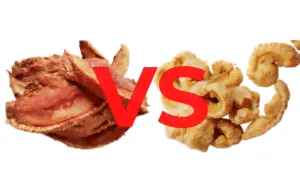
Pork rind and chicharrones are pretty different despite using the same ingredients and techniques to prepare them.
What sets them apart is that pork rind is made from only skin with no meat or fat. On the other hand, chicharrones contain some fat and meat.
How long can Chicharron last?
Unlike store-bought pork skin chips, homemade pork skin chips should be kept in an airtight container in the refrigerator. It is not advised that they be stored at room temperature.
Five days is the average time you can eat chicharrones noticing no taste changes. After five days, they usually go rancid.
Although they’re delicious right out of the fridge, it’s better to take them out about 30 minutes before serving.
What do chicharrones taste like?
Chicharrones have a mild pork taste and a crunchy texture. They are fantastic when seasoned only with salt, but their flavor profile makes them an ideal canvas for other seasonings.
What’s the difference between chicharrones and cracklings?
Pig rinds cook puffily and remain puffy after cooking as they have no fats linked to the skin.
Chicharrones is Spanish for pig rinds with some meat. As for the cracklings, they are a simpler name for the chicharrones. “Chicharrones Con Gasa” is another name for Costa Rica and Puerto Rico chicharrones.
How many chicharrones can I eat on keto?
You can eat as many chicharrones on keto as you like and have the appetite for, keeping your macros in view. But make sure the oil you use to fry chicharrones is also keto-friendly. Most keto oils don’t have higher smoke points, so you can better use lard (pig fat).
Conclusion
Chicharrones are slated, deep-fried pork belly skin. They have a wonderful salty flavor, similar to bacon-flavored rice chips.
They’re light and fluffy. Chicharrones are either eaten independently or dipped in tomato salsa, guacamole, or melted cheese! These crispy fried pork skin snacks can be fantastic if you want to get energy from fat and avoid carbohydrates.
